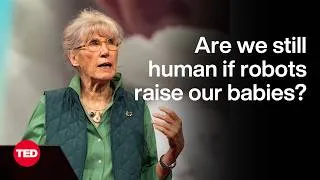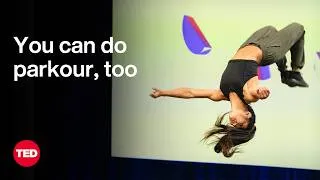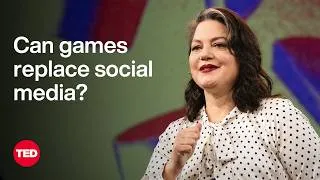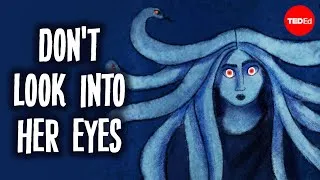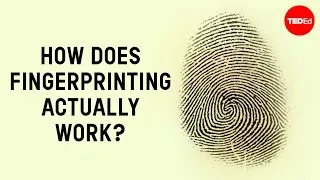请双击下面的英文字幕来播放视频。
翻译人员: Hua Liu
校对人员: Amy Zerotus
00:18
My talk is "Flapping Birds and Space Telescopes."
0
18330
3000
我演讲的题目是《展翅的鸟儿与太空望远镜》。
00:21
And you would think that should have nothing to do with one another,
1
21330
2000
你会觉得他们相互之间没有联系,
00:23
but I hope by the end of these 18 minutes,
2
23330
3000
但我希望在18分钟以后,
00:26
you'll see a little bit of a relation.
3
26330
2000
你能看到一些关联。
00:29
It ties to origami. So let me start.
4
29330
1000
这与折纸有关。下面我就开始了。
00:30
What is origami?
5
30330
2000
什么是折纸?
00:32
Most people think they know what origami is. It's this:
6
32330
3000
很多人以为他们知道折纸是什么。它是这样的:
00:35
flapping birds, toys, cootie catchers, that sort of thing.
7
35330
3000
展翅的鸟儿、玩具、东西南北之类的东西。
00:38
And that is what origami used to be.
8
38330
2000
折纸术以前是这样的。
00:40
But it's become something else.
9
40330
2000
但它已经改变了。
00:42
It's become an art form, a form of sculpture.
10
42330
2000
它已经成为了一种艺术形式,一种雕塑形式。
00:44
The common theme -- what makes it origami --
11
44330
2000
共同的主题——折纸术的本质——
00:46
is folding is how we create the form.
12
46330
4000
是折叠,也是我们如何创造形态的。
00:50
You know, it's very old. This is a plate from 1797.
13
50330
3000
你们知道,这非常古老。这是1797年的一幅画。
00:53
It shows these women playing with these toys.
14
53330
2000
上面是这些妇女们玩纸玩具的场景。
00:55
If you look close, it's this shape, called a crane.
15
55330
3000
如果你靠近点看,它是这种形状的,叫做鹤。
00:58
Every Japanese kid
16
58330
2000
每个日本孩子
01:00
learns how to fold that crane.
17
60330
2000
都学折纸鹤。
01:02
So this art has been around for hundreds of years,
18
62330
2000
所以这种艺术已经存在了数百年,
01:04
and you would think something
19
64330
2000
你可能会想如果某种东西
01:06
that's been around that long -- so restrictive, folding only --
20
66330
3000
已经存在了这么久——如此有限制性,只能折叠——
01:09
everything that could be done has been done a long time ago.
21
69330
3000
那么所有能做出的东西应该在很久以前就做出来了。
01:12
And that might have been the case.
22
72330
2000
实际情况也许会是如此。
01:14
But in the twentieth century,
23
74330
2000
但在20世纪,
01:16
a Japanese folder named Yoshizawa came along,
24
76330
3000
一位名为吉泽的日本折纸艺术家出现了,
01:19
and he created tens of thousands of new designs.
25
79330
3000
他创造出了数万种全新的设计。
01:22
But even more importantly, he created a language,
26
82330
3000
更重要的是,他创造了一种语言——
01:25
a way we could communicate,
27
85330
2000
一种我们可以交流的方式,
01:27
a code of dots, dashes and arrows.
28
87330
2000
一种由点、破折号和箭头构成的代码。
01:29
Harkening back to Susan Blackmore's talk,
29
89330
2000
联系到苏珊·布莱克摩尔的演讲,
01:31
we now have a means of transmitting information
30
91330
2000
我们现在有了一种通过传承与选择
01:33
with heredity and selection,
31
93330
3000
传递信息的方法,
01:36
and we know where that leads.
32
96330
2000
我们也知道它的走向。
01:38
And where it has led in origami
33
98330
2000
而它在折纸术中产生的
01:40
is to things like this.
34
100330
2000
是这样的东西。
01:42
This is an origami figure --
35
102330
2000
这是一个折纸作品:
01:44
one sheet, no cuts, folding only, hundreds of folds.
36
104330
4000
一张纸,没有裁剪,只有折叠,数百次折叠。
01:50
This, too, is origami,
37
110330
2000
而这也是折纸,
01:52
and this shows where we've gone in the modern world.
38
112330
3000
它显示出我们在现代世界中的已经走到哪了。
01:55
Naturalism. Detail.
39
115330
2000
自然主义。细节。
01:57
You can get horns, antlers --
40
117330
2000
你可以做出犄角,鹿角——
01:59
even, if you look close, cloven hooves.
41
119330
2000
如果你靠近看,偶蹄。
02:01
And it raises a question: what changed?
42
121330
3000
这就引出一个问题:什么发生了改变?
02:04
And what changed is something
43
124330
2000
发生变化的是一种
02:06
you might not have expected in an art,
44
126330
3000
你在艺术中可能不曾期待的东西,
02:09
which is math.
45
129330
2000
那就是数学。
02:11
That is, people applied mathematical principles
46
131330
2000
也就是说,人们将数学原理应用
02:13
to the art,
47
133330
3000
到艺术中,
02:16
to discover the underlying laws.
48
136330
2000
来发现潜在的规律。
02:18
And that leads to a very powerful tool.
49
138330
3000
这就形成了一种强大的工具。
02:21
The secret to productivity in so many fields --
50
141330
2000
在众多领域提高生产力的秘密——
02:23
and in origami --
51
143330
2000
包括在折纸术中——
02:25
is letting dead people do your work for you.
52
145330
3000
是让死去的人为你工作。
02:28
(Laughter)
53
148330
1000
(笑声)
02:29
Because what you can do is
54
149330
2000
因为你所能做的
02:31
take your problem,
55
151330
2000
是将你的问题
02:33
and turn it into a problem that someone else has solved,
56
153330
3000
转变成一个其他人已经解决的问题,
02:36
and use their solutions.
57
156330
2000
并运用他们的解决方法。
02:38
And I want to tell you how we did that in origami.
58
158330
3000
而我想要告诉你们,我们是如何在折纸术中做到这一点的。
02:41
Origami revolves around crease patterns.
59
161330
2000
折纸术是围绕折痕图进行的。
02:43
The crease pattern shown here is the underlying blueprint
60
163330
2000
这个折痕图就是一个折纸造型
02:46
for an origami figure.
61
166330
2000
的设计图
02:48
And you can't just draw them arbitrarily.
62
168330
2000
设计图可不能随便画。
02:50
They have to obey four simple laws.
63
170330
3000
它们必须遵循4个简单的规则。
02:53
And they're very simple, easy to understand.
64
173330
2000
它们非常简单,并且很好理解。
02:55
The first law is two-colorability. You can color any crease pattern
65
175330
3000
第一个规则是双可着色性。你可以用两种颜色
02:58
with just two colors without ever having
66
178330
2000
填充你想画的的折痕图而
03:00
the same color meeting.
67
180330
3000
相同的颜色不会相邻。
03:03
The directions of the folds at any vertex --
68
183330
3000
在任何顶点的折叠方向--
03:06
the number of mountain folds, the number of valley folds --
69
186330
3000
凸折法的数量,凹折法的数量--
03:09
always differs by two. Two more or two less.
70
189330
2000
之间总是相差两下。多折或少折两下。
03:11
Nothing else.
71
191330
2000
就这么简单。
03:13
If you look at the angles around the fold,
72
193330
2000
如果观察折痕周围的角,
03:15
you find that if you number the angles in a circle,
73
195330
2000
你会发现在数围成一圈的角时,
03:17
all the even-numbered angles add up to a straight line,
74
197330
3000
所有列为偶数的角加起来是一条直线。
03:20
all the odd-numbered angles add up to a straight line.
75
200330
3000
所有列为奇数的角加起来是一个直线。
03:23
And if you look at how the layers stack,
76
203330
2000
接下来,如果观察这些纸是怎么叠加起来的,
03:25
you'll find that no matter how you stack folds and sheets,
77
205330
3000
你会发现不论怎样叠加褶层和纸片,
03:28
a sheet can never
78
208330
2000
纸片永远不能
03:30
penetrate a fold.
79
210330
2000
穿透褶层。
03:32
So that's four simple laws. That's all you need in origami.
80
212330
3000
这就是四则简单的规则。在折纸艺术中这就是全部。
03:35
All of origami comes from that.
81
215330
2000
所有的折纸都源于这些。
03:37
And you'd think, "Can four simple laws
82
217330
2000
现在你觉得:“那些复杂的工艺
03:39
give rise to that kind of complexity?"
83
219330
2000
能是从四则简单的规则中衍生出来的吗?”
03:41
But indeed, the laws of quantum mechanics
84
221330
2000
但是,事实上,量子力学的法则
03:43
can be written down on a napkin,
85
223330
2000
可以在一张餐巾纸上写出来。
03:45
and yet they govern all of chemistry,
86
225330
2000
而它们可以支配所有的化学,
03:47
all of life, all of history.
87
227330
2000
甚至生活和历史的全部。
03:49
If we obey these laws,
88
229330
2000
如果遵循这些规则,
03:51
we can do amazing things.
89
231330
2000
我们能做出令人吃惊的事。
03:53
So in origami, to obey these laws,
90
233330
2000
所以折纸时,在遵循这些规则的情况下,
03:55
we can take simple patterns --
91
235330
2000
我们可以做出简单的样式--
03:57
like this repeating pattern of folds, called textures --
92
237330
3000
比如这个重复的折叠样式,叫做纹理--
04:00
and by itself it's nothing.
93
240330
2000
虽然这样单独看起来很普通。
04:02
But if we follow the laws of origami,
94
242330
2000
但如果我们遵守折纸的规则,
04:04
we can put these patterns into another fold
95
244330
3000
我们能把这些样式加入另一种折法,
04:07
that itself might be something very, very simple,
96
247330
2000
这种折法本身非常非常的简单。
04:09
but when we put it together,
97
249330
2000
但当我们把它加进来,
04:11
we get something a little different.
98
251330
2000
会得到很不一样的东西。
04:13
This fish, 400 scales --
99
253330
3000
这条鱼有400片鱼鳞,
04:16
again, it is one uncut square, only folding.
100
256330
3000
同样,它是一张没被剪过的正方形纸张。
04:20
And if you don't want to fold 400 scales,
101
260330
2000
如果你不想折400片鱼鳞,
04:22
you can back off and just do a few things,
102
262330
2000
你可以退而求其次,做些简单的折叠
04:24
and add plates to the back of a turtle, or toes.
103
264330
3000
得到一只乌龟的背壳或脚趾。
04:27
Or you can ramp up and go up to 50 stars
104
267330
3000
或者可以提升成为一面拥有
04:30
on a flag, with 13 stripes.
105
270330
3000
50颗星星和13条横条的旗子(美国国旗)。
04:33
And if you want to go really crazy,
106
273330
3000
如果你想做些疯狂的事情,
04:36
1,000 scales on a rattlesnake.
107
276330
2000
这有一条有1000片鳞片的响尾蛇。
04:38
And this guy's on display downstairs,
108
278330
2000
这个作品展示在楼下,
04:40
so take a look if you get a chance.
109
280330
3000
所以你们有机会可以看看。
04:43
The most powerful tools in origami
110
283330
2000
在折纸艺术中,最有用的方法
04:45
have related to how we get parts of creatures.
111
285330
3000
和我们怎样构造生物的一部分有关。
04:48
And I can put it in this simple equation.
112
288330
2000
我可以用一个简单的等式来解释。
04:50
We take an idea,
113
290330
2000
我们产生了一个想法,
04:52
combine it with a square, and you get an origami figure.
114
292330
3000
把它与张纸片结合,就能得到一个折纸作品。
04:55
(Laughter)
115
295330
4000
(笑声)
04:59
What matters is what we mean by those symbols.
116
299330
2000
重要的是这些符号代表什么。
05:01
And you might say, "Can you really be that specific?
117
301330
3000
你们可能会问:“真的能做到那么具体吗?
05:04
I mean, a stag beetle -- it's got two points for jaws,
118
304330
2000
我是说一只鹿角虫有两个点状的嘴,
05:06
it's got antennae. Can you be that specific in the detail?"
119
306330
4000
和触角。你真的能做到具体到细节吗?”
05:10
And yeah, you really can.
120
310330
3000
是的,真的可以。
05:13
So how do we do that? Well, we break it down
121
313330
3000
那该怎么做呢?我们把它分成
05:16
into a few smaller steps.
122
316330
2000
几个小步骤。
05:18
So let me stretch out that equation.
123
318330
2000
为此,让我来展开这个等式。
05:20
I start with my idea. I abstract it.
124
320330
3000
我先从我的构思开始,使它抽象化。
05:23
What's the most abstract form? It's a stick figure.
125
323330
3000
什么是最抽象的形式呢?线条画。
05:26
And from that stick figure, I somehow have to get to a folded shape
126
326330
3000
然后从这个线条画,我得用某种方式得到折叠的式样,
05:29
that has a part for every bit of the subject,
127
329330
3000
并且包括想要表现对象的所有部分。
05:32
a flap for every leg.
128
332330
2000
一片三角形折叠对应一条腿。
05:34
And then once I have that folded shape that we call the base,
129
334330
3000
然后,我们称这个折叠的式样为基础。
05:37
you can make the legs narrower, you can bend them,
130
337330
3000
你可以使它的腿变细,使其弯曲,
05:40
you can turn it into the finished shape.
131
340330
2000
你可以把它做成成品。
05:42
Now the first step, pretty easy.
132
342330
2000
第一步:很简单。
05:44
Take an idea, draw a stick figure.
133
344330
2000
做出一个构思,画一幅线条图。
05:46
The last step is not so hard, but that middle step --
134
346330
3000
最后一步也不是很难,但中间的一步--
05:49
going from the abstract description to the folded shape --
135
349330
3000
把抽象的描绘变为折叠的式样--
05:52
that's hard.
136
352330
2000
这很难。
05:54
But that's the place where the mathematical ideas
137
354330
2000
但就是在这,数学理论让我们
05:56
can get us over the hump.
138
356330
2000
翻越难关。
05:58
And I'm going to show you all how to do that
139
358330
2000
我要向你们展示怎样做,
06:00
so you can go out of here and fold something.
140
360330
2000
这样离开这里后,你们可以叠出些东西。
06:02
But we're going to start small.
141
362330
2000
但我们要先从小的开始。
06:04
This base has a lot of flaps in it.
142
364330
2000
这个基础有很多片状物。
06:06
We're going to learn how to make one flap.
143
366330
3000
我们要学习怎样做一个片状物。
06:09
How would you make a single flap?
144
369330
2000
你会怎样叠一个片状物呢?
06:11
Take a square. Fold it in half, fold it in half, fold it again,
145
371330
3000
拿一张正方形的纸,把它对折再对折,
06:14
until it gets long and narrow,
146
374330
2000
直到它变得又长又细,
06:16
and then we'll say at the end of that, that's a flap.
147
376330
2000
然后这个的尾部就是一个片状物。
06:18
I could use that for a leg, an arm, anything like that.
148
378330
3000
我能用它做一条腿,一只手臂,和所有相似的东西。
06:21
What paper went into that flap?
149
381330
2000
在片状物中是什么样的纸呢?
06:23
Well, if I unfold it and go back to the crease pattern,
150
383330
2000
如果把它展开去看它的折痕图,
06:25
you can see that the upper left corner of that shape
151
385330
3000
你们可以看到在纸片的左上角的形状
06:28
is the paper that went into the flap.
152
388330
2000
就是构成片状物的纸。
06:30
So that's the flap, and all the rest of the paper's left over.
153
390330
3000
所以那就是一个片状物,和所有剩下的纸。
06:33
I can use it for something else.
154
393330
2000
我可以用剩下的部分做点别的。
06:35
Well, there are other ways of making a flap.
155
395330
2000
也有另外的做片状物的方法。
06:37
There are other dimensions for flaps.
156
397330
2000
也有不同形状的片状物。
06:39
If I make the flaps skinnier, I can use a bit less paper.
157
399330
3000
如果把片状物叠得更细一些,所用的纸会更少。
06:42
If I make the flap as skinny as possible,
158
402330
3000
如果把片状物尽可能的叠细,
06:45
I get to the limit of the minimum amount of paper needed.
159
405330
3000
就能只用片状物所需的最少的纸。
06:48
And you can see there, it needs a quarter-circle of paper to make a flap.
160
408330
3000
就像你们所看到的,只需要纸上四分之一个圆就可以作出一个片状物。
06:52
There's other ways of making flaps.
161
412330
2000
还有别的做片状物的方法。
06:54
If I put the flap on the edge, it uses a half circle of paper.
162
414330
3000
如果把片状物放在纸片边上,就需要一个半圆的纸。
06:57
And if I make the flap from the middle, it uses a full circle.
163
417330
3000
如果把片状物放在纸片的中心,就需要一整圆。
07:00
So, no matter how I make a flap,
164
420330
2000
就是说不论怎样叠,
07:02
it needs some part
165
422330
2000
片状物是由
07:04
of a circular region of paper.
166
424330
2000
纸上圆形区域的一部分做成的。
07:06
So now we're ready to scale up.
167
426330
2000
现在让我们来提升到新的水平。
07:08
What if I want to make something that has a lot of flaps?
168
428330
3000
如果要叠一个有很多片状物的东西该怎么办呢?
07:11
What do I need? I need a lot of circles.
169
431330
3000
我需要什么?我需要很多的圆。
07:15
And in the 1990s,
170
435330
2000
在二十世纪九十年代,
07:17
origami artists discovered these principles
171
437330
2000
折纸艺术家发现了这些规则,
07:19
and realized we could make arbitrarily complicated figures
172
439330
3000
并了解到我们可以通过组合圆形
07:22
just by packing circles.
173
442330
3000
来叠出任意复杂的形状。
07:25
And here's where the dead people start to help us out,
174
445330
3000
这就是那些死去的人能帮到我们的地方。
07:28
because lots of people have studied
175
448330
3000
因为很多人都研究过
07:31
the problem of packing circles.
176
451330
2000
组合圆形的问题。
07:33
I can rely on that vast history of mathematicians and artists
177
453330
3000
我可以依赖那些有关圆的组合和排列的
07:36
looking at disc packings and arrangements.
178
456330
3000
大量的数学与艺术的历史。
07:39
And I can use those patterns now to create origami shapes.
179
459330
3000
然后我可以用这些式样来制造折纸的形状。
07:43
So we figured out these rules whereby you pack circles,
180
463330
2000
我们可以依据这些规则来组合圆形,
07:45
you decorate the patterns of circles with lines
181
465330
3000
依据更多的规矩我们可以
07:48
according to more rules. That gives you the folds.
182
468330
2000
用线条来装饰圆。这就有了折叠线。
07:50
Those folds fold into a base. You shape the base.
183
470330
3000
沿这些线折叠就可以得到大体形状。你们就做出了大体的形状。
07:53
You get a folded shape -- in this case, a cockroach.
184
473330
3000
你们得到一个折叠的形状,在这里,是一只蟑螂。
07:57
And it's so simple.
185
477330
2000
而且它非常的简单。
07:59
(Laughter)
186
479330
3000
(笑声)
08:02
It's so simple that a computer could do it.
187
482330
3000
因为它很简单,电脑就可以把它做出来。
08:05
And you say, "Well, you know, how simple is that?"
188
485330
2000
你们可能问“那能有多简单呢?”
08:07
But computers -- you need to be able to describe things
189
487330
2000
但是要用电脑,你们需要用最基本的方法
08:09
in very basic terms, and with this, we could.
190
489330
3000
来描述一件事物。而这里我们可以做到。
08:12
So I wrote a computer program a bunch of years ago
191
492330
2000
所以我在很多年前写了一个电脑程序,
08:14
called TreeMaker, and you can download it from my website.
192
494330
2000
叫做TreeMaker(造树者),你们可以在我的网页上下载它。
08:16
It's free. It runs on all the major platforms -- even Windows.
193
496330
3000
它是免费的。它可以在大部分的操作系统里面运行,甚至在Windows里。
08:19
(Laughter)
194
499330
2000
(笑声)
08:21
And you just draw a stick figure,
195
501330
2000
然后你们就可以自己画一个线条图,
08:23
and it calculates the crease pattern.
196
503330
2000
这个程序会根据线条图计算折痕。
08:25
It does the circle packing, calculates the crease pattern,
197
505330
3000
这个程序可以排列圆形,计算折痕,
08:28
and if you use that stick figure that I just showed --
198
508330
2000
还有如果你们用刚才我展示的线条图,
08:30
which you can kind of tell, it's a deer, it's got antlers --
199
510330
3000
你们可以看出它是一只有角的鹿,
08:33
you'll get this crease pattern.
200
513330
2000
你们就可以得到这个折痕图。
08:35
And if you take this crease pattern, you fold on the dotted lines,
201
515330
2000
用这个折痕图,折叠有虚线的地方,
08:37
you'll get a base that you can then shape
202
517330
3000
你们就能得到一个基础,然后再用
08:40
into a deer,
203
520330
2000
你们想用的方法
08:42
with exactly the crease pattern that you wanted.
204
522330
2000
叠出一只鹿。
08:44
And if you want a different deer,
205
524330
2000
如果你们想要一只不同种的鹿,
08:46
not a white-tailed deer, but you want a mule deer, or an elk,
206
526330
3000
而不是白尾鹿,
08:49
you change the packing,
207
529330
2000
你们可以改变圆形的排列,
08:51
and you can do an elk.
208
531330
2000
然后得到一只麋鹿。
08:53
Or you could do a moose.
209
533330
2000
或是一只驼鹿。
08:55
Or, really, any other kind of deer.
210
535330
2000
或是其它任何一种鹿。
08:57
These techniques revolutionized this art.
211
537330
3000
这些技术改革了这门艺术。
09:00
We found we could do insects,
212
540330
2000
我们发现我们可以叠出昆虫,
09:02
spiders, which are close,
213
542330
2000
或是相近的蜘蛛,
09:04
things with legs, things with legs and wings,
214
544330
3000
有脚的东西,有脚和翅膀的东西,
09:08
things with legs and antennae.
215
548330
2000
和有脚和触角的东西。
09:10
And if folding a single praying mantis from a single uncut square
216
550330
3000
如果用一张没剪过的正方形纸叠一只螳螂
09:13
wasn't interesting enough,
217
553330
2000
还不够有趣的话,
09:15
then you could do two praying mantises
218
555330
2000
你们可以用一张没剪过的正方形纸
09:17
from a single uncut square.
219
557330
2000
叠两只螳螂。
09:19
She's eating him.
220
559330
2000
她在吃他。
09:21
I call it "Snack Time."
221
561330
3000
我称之为“点心时间”。
09:24
And you can do more than just insects.
222
564330
2000
你们能做的不只是昆虫。
09:26
This -- you can put details,
223
566330
2000
你们可以把它做到有细节,
09:28
toes and claws. A grizzly bear has claws.
224
568330
3000
像指头和爪子。一只有爪子的北美洲灰熊。
09:31
This tree frog has toes.
225
571330
2000
和这只有脚趾的树蛙。
09:33
Actually, lots of people in origami now put toes into their models.
226
573330
3000
实际上,在折纸艺术中有很多人把指头加入到他们的模型中。
09:36
Toes have become an origami meme,
227
576330
2000
指头变成了折纸艺术的文化基因。
09:38
because everyone's doing it.
228
578330
3000
因为每个人都在做。
09:41
You can make multiple subjects.
229
581330
2000
你可以做出多种的物体。
09:43
So these are a couple of instrumentalists.
230
583330
2000
像这里有一些音乐家。
09:45
The guitar player from a single square,
231
585330
3000
一个正方形做出的吉他手。
09:48
the bass player from a single square.
232
588330
2000
一个正方形做出的贝斯手。
09:50
And if you say, "Well, but the guitar, bass --
233
590330
2000
如果你说,“好吧,但吉他和贝斯
09:52
that's not so hot.
234
592330
2000
不够帅。
09:54
Do a little more complicated instrument."
235
594330
2000
做些更复杂的乐器吧。”
09:56
Well, then you could do an organ.
236
596330
2000
那你可以做一架风琴。
09:58
(Laughter)
237
598330
3000
(笑声)
10:01
And what this has allowed is the creation
238
601330
2000
所以在这个世界里我们能
10:03
of origami-on-demand.
239
603330
2000
做出所需要的创造。
10:05
So now people can say, "I want exactly this and this and this,"
240
605330
3000
如果现在有人说,我想要这个这个还有这个。
10:08
and you can go out and fold it.
241
608330
3000
你就可以精确的把它们叠出来。
10:11
And sometimes you create high art,
242
611330
2000
有时可以做纯艺术。
10:13
and sometimes you pay the bills by doing some commercial work.
243
613330
3000
有时可以做些商品卖钱。
10:16
But I want to show you some examples.
244
616330
2000
但是我想给你们看一些例子。
10:18
Everything you'll see here,
245
618330
2000
除了车子,
10:20
except the car, is origami.
246
620330
3000
你们将看到的所有东西都是折纸。
10:23
(Video)
247
623330
28000
(影片)
10:51
(Applause)
248
651330
3000
(掌声)
10:54
Just to show you, this really was folded paper.
249
654330
3000
就是想展示给你们这些真实的折纸。
10:57
Computers made things move,
250
657330
2000
电脑使所有的东西动起来。
10:59
but these were all real, folded objects that we made.
251
659330
3000
但是这些折纸全都是货真价实的。
11:03
And we can use this not just for visuals,
252
663330
3000
我们不只可以在视觉上运用到折纸艺术,
11:06
but it turns out to be useful even in the real world.
253
666330
3000
它实际上在现实世界中也很有用。
11:09
Surprisingly, origami
254
669330
1000
令人惊奇的,折纸
11:10
and the structures that we've developed in origami
255
670330
3000
和从折纸中发展出来的结构
11:13
turn out to have applications in medicine, in science,
256
673330
3000
可以在医药学,科学,
11:16
in space, in the body, consumer electronics and more.
257
676330
3000
太空,身体和电子产品等等上得到应用。
11:19
And I want to show you some of these examples.
258
679330
3000
我想展示一些例子。
11:22
One of the earliest was this pattern,
259
682330
2000
在最早的应用中有这样一个样式,
11:24
this folded pattern,
260
684330
2000
折纸样式,
11:26
studied by Koryo Miura, a Japanese engineer.
261
686330
3000
由日本的工程师Koryo Miura发明的。
11:29
He studied a folding pattern, and realized
262
689330
2000
他研究这个折纸样式,然后发现
11:31
this could fold down into an extremely compact package
263
691330
3000
可以折出很紧凑的包装,
11:34
that had a very simple opening and closing structure.
264
694330
3000
有很简单的开口和闭合结构。
11:37
And he used it to design this solar array.
265
697330
3000
他应用这个技术设计了这个太阳能电池板。
11:40
It's an artist's rendition, but it flew in a Japanese telescope
266
700330
3000
这是一个艺术家的表演,但它在1995应用到了
11:43
in 1995.
267
703330
2000
一架日本望远镜。
11:45
Now, there is actually a little origami
268
705330
2000
现在在詹姆斯韦伯太空望远镜中只有
11:47
in the James Webb Space Telescope, but it's very simple.
269
707330
3000
一点点的折纸艺术,但它十分之简单。
11:50
The telescope, going up in space,
270
710330
2000
这架进入太空的望远镜
11:52
it unfolds in two places.
271
712330
3000
在两处展开。
11:55
It folds in thirds. It's a very simple pattern --
272
715330
2000
它在第三个处折叠。它是一个很简单的式样,
11:57
you wouldn't even call that origami.
273
717330
2000
你都不会把它称作折纸。
11:59
They certainly didn't need to talk to origami artists.
274
719330
3000
这些科学家的确不用跟折纸艺术家讨论。
12:02
But if you want to go higher and go larger than this,
275
722330
3000
但当你要更深入的研究时,
12:05
then you might need some origami.
276
725330
2000
折纸术是必需的。
12:07
Engineers at Lawrence Livermore National Lab
277
727330
2000
劳伦斯利物穆尔国家实验室的工程师们
12:09
had an idea for a telescope much larger.
278
729330
3000
有一个关于一个更大的望远镜的构想。
12:12
They called it the Eyeglass.
279
732330
2000
他们称之为“镜片”。
12:14
The design called for geosynchronous orbit
280
734330
2000
这个设计需要同步轨道,
12:16
25,000 miles up,
281
736330
2000
高于地面26000英里,
12:18
100-meter diameter lens.
282
738330
3000
和直径100米的镜片。
12:21
So, imagine a lens the size of a football field.
283
741330
3000
所以镜片有一个橄榄球场那么大。
12:24
There were two groups of people who were interested in this:
284
744330
2000
有两类人对这个望远镜有兴趣:
12:26
planetary scientists, who want to look up,
285
746330
3000
想要观察太空的行星学家,
12:29
and then other people, who wanted to look down.
286
749330
3000
和其他想要观察地球的人。
12:33
Whether you look up or look down,
287
753330
2000
不论你想观察什么,
12:35
how do you get it up in space? You've got to get it up there in a rocket.
288
755330
3000
该怎么上太空呢?你需要一个火箭。
12:38
And rockets are small. So you have to make it smaller.
289
758330
3000
而且火箭一般都很小。所以你需要把望远镜做的小一些。
12:41
How do you make a large sheet of glass smaller?
290
761330
2000
怎么把一大片玻璃变小呢?
12:43
Well, about the only way is to fold it up somehow.
291
763330
3000
唯一的办法就是折叠。
12:46
So you have to do something like this.
292
766330
2000
所以你要做这样的事,
12:48
This was a small model.
293
768330
2000
这一个小型的模型。
12:51
Folded lens, you divide up the panels, you add flexures.
294
771330
2000
对于镜片,你把板面分区然后加上弯曲。
12:53
But this pattern's not going to work
295
773330
3000
但是这个样式不能把100米的东西
12:56
to get something 100 meters down to a few meters.
296
776330
3000
变成几米。
12:59
So the Livermore engineers,
297
779330
2000
所以利物穆尔的工程师们,
13:01
wanting to make use of the work of dead people,
298
781330
2000
想要利用那些死去的人的成果,
13:03
or perhaps live origamists, said,
299
783330
3000
或是活着的折纸艺术家的成果。
13:06
"Let's see if someone else is doing this sort of thing."
300
786330
3000
工程师们说“看看有没有别人在做这类事。”
13:09
So they looked into the origami community,
301
789330
3000
所以他们研究折纸圈。
13:12
we got in touch with them, and I started working with them.
302
792330
2000
我们和折纸艺术家取得联系,而我开始和他们一起工作。
13:14
And we developed a pattern together
303
794330
2000
我们一起开发了一个
13:16
that scales to arbitrarily large size,
304
796330
2000
可以应用到任意大小,
13:18
but that allows any flat ring or disc
305
798330
4000
但可以允许所有的平面环或圆盘
13:22
to fold down into a very neat, compact cylinder.
306
802330
3000
折成一个整洁紧凑的圆柱体的样式。
13:25
And they adopted that for their first generation,
307
805330
2000
他们在第一代的望远镜中采用了这个样式。
13:27
which was not 100 meters -- it was a five-meter.
308
807330
2000
而第一代并不是100米而是5米。
13:29
But this is a five-meter telescope --
309
809330
2000
但是这个5米的望远镜
13:31
has about a quarter-mile focal length.
310
811330
2000
有0.25英里的焦距。
13:33
And it works perfectly on its test range,
311
813330
2000
而且在它的测试范围内效果很好。
13:35
and it indeed folds up into a neat little bundle.
312
815330
3000
它也的确被叠成了一小捆。
13:39
Now, there is other origami in space.
313
819330
2000
现在,还有别的折纸术应用到太空中。
13:41
Japan Aerospace [Exploration] Agency flew a solar sail,
314
821330
3000
日本航空【探索者】部门发射了一个太阳光帆。
13:44
and you can see here that the sail expands out,
315
824330
3000
你们可以看到帆伸展开,
13:47
and you can still see the fold lines.
316
827330
2000
还有帆上的折叠线。
13:49
The problem that's being solved here is
317
829330
3000
在这里所被解决的问题是
13:52
something that needs to be big and sheet-like at its destination,
318
832330
3000
做出了一个在旅途中很小
13:55
but needs to be small for the journey.
319
835330
2000
但在目的地很大的薄片状的物体。
13:57
And that works whether you're going into space,
320
837330
3000
这个可以作用于当你想进入太空,
14:00
or whether you're just going into a body.
321
840330
3000
或是想进入人的身体时。
14:03
And this example is the latter.
322
843330
2000
这个例子就是进入人身体的。
14:05
This is a heart stent developed by Zhong You
323
845330
3000
这是由牛津大学的钟游发明的
14:08
at Oxford University.
324
848330
2000
心脏手术支架。
14:10
It holds open a blocked artery when it gets to its destination,
325
850330
3000
它在到达目的地时会打开被堵塞的动脉血管。
14:13
but it needs to be much smaller for the trip there,
326
853330
3000
但在旅途中它需要变得很小才能通过
14:16
through your blood vessels.
327
856330
2000
你的血管。
14:18
And this stent folds down using an origami pattern,
328
858330
3000
这个支架运用一种折纸术被叠小。
14:21
based on a model called the water bomb base.
329
861330
3000
我们称这个模型为水弹模型。
14:25
Airbag designers also have the problem
330
865330
2000
安全气囊的设计师也遇到了同样的
14:27
of getting flat sheets
331
867330
2000
把大薄片塞进小空间里的
14:29
into a small space.
332
869330
3000
问题。
14:32
And they want to do their design by simulation.
333
872330
2000
而且他们都是通过仿真技术来做设计。
14:34
So they need to figure out how, in a computer,
334
874330
2000
所以他们需要在电脑里研究出
14:36
to flatten an airbag.
335
876330
2000
怎样使安全气囊变平。
14:38
And the algorithms that we developed
336
878330
2000
我们所开发出的叠昆虫的
14:40
to do insects
337
880330
2000
算法在这里变成了
14:42
turned out to be the solution for airbags
338
882330
3000
在仿真技术中解决安全气囊问题的
14:45
to do their simulation.
339
885330
2000
方法。
14:47
And so they can do a simulation like this.
340
887330
3000
所以设计师可以做一个这个的模仿。
14:50
Those are the origami creases forming,
341
890330
2000
那些就是折纸的折痕,
14:52
and now you can see the airbag inflate
342
892330
2000
现在你们所看到的就是正在放气的安全气囊
14:54
and find out, does it work?
343
894330
3000
并且大家可以知道这方法管不管用。
14:57
And that leads
344
897330
2000
这个例子实际上可以
14:59
to a really interesting idea.
345
899330
2000
推导出一个十分有趣的构想。
15:01
You know, where did these things come from?
346
901330
3000
你们知道,这些发明设计都是从哪来么?
15:04
Well, the heart stent
347
904330
2000
这个心脏手术支架
15:06
came from that little blow-up box
348
906330
2000
是从大家小学就学到的
15:08
that you might have learned in elementary school.
349
908330
3000
纸气球中衍生来的。
15:11
It's the same pattern, called the water bomb base.
350
911330
3000
它们有着相同的构造,称之为“水弹模型”。
15:14
The airbag-flattening algorithm
351
914330
2000
那个使安全气囊变平的算法是
15:16
came from all the developments
352
916330
2000
从那些实际上只是
15:18
of circle packing and the mathematical theory
353
918330
3000
发明出来用来叠昆虫,
15:21
that was really developed
354
921330
2000
也就是有腿的东西,
15:23
just to create insects -- things with legs.
355
923330
3000
的数学理论。
15:27
The thing is, that this often happens
356
927330
2000
其实呢,这样的事经常
15:29
in math and science.
357
929330
2000
发生在数学和科学里面。
15:31
When you get math involved, problems that you solve
358
931330
3000
当你运用数学,解决
15:34
for aesthetic value only,
359
934330
2000
你纯粹为了美学价值
15:36
or to create something beautiful,
360
936330
2000
或是创造美而想解决的问题时,
15:38
turn around and turn out
361
938330
2000
实际上结果反过来
15:40
to have an application in the real world.
362
940330
3000
在现实世界中也可以应用。
15:43
And as weird and surprising as it may sound,
363
943330
3000
而且即使听上去很奇怪,
15:46
origami may someday even save a life.
364
946330
3000
折纸术有一天可能会救人一命。
15:50
Thanks.
365
950330
2000
谢谢。
15:52
(Applause)
366
952330
2000
(掌声)
New videos
关于本网站
这个网站将向你介绍对学习英语有用的YouTube视频。你将看到来自世界各地的一流教师教授的英语课程。双击每个视频页面上显示的英文字幕,即可从那里播放视频。字幕会随着视频的播放而同步滚动。如果你有任何意见或要求,请使用此联系表与我们联系。



